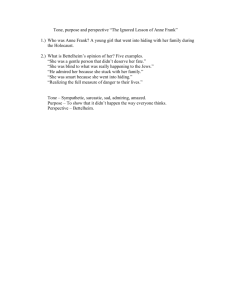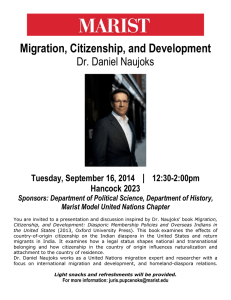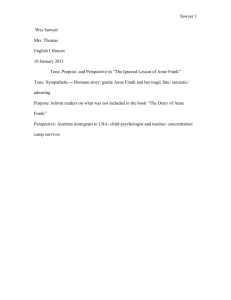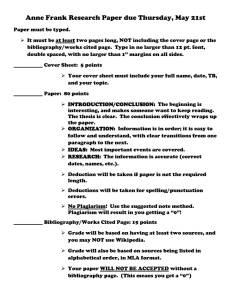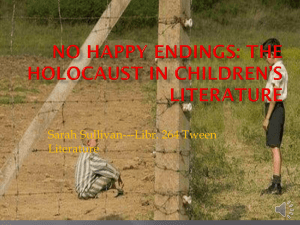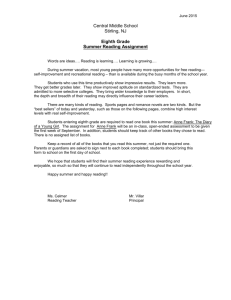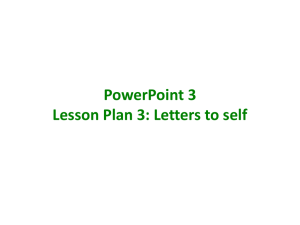N
advertisement
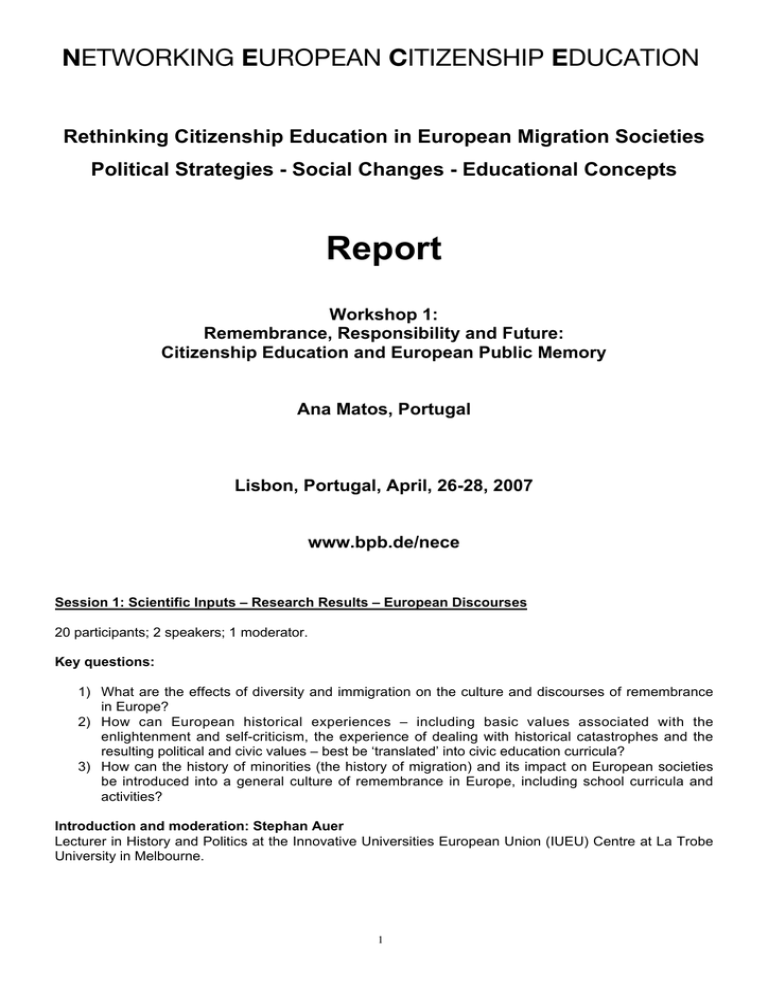
NETWORKING EUROPEAN CITIZENSHIP EDUCATION Rethinking Citizenship Education in European Migration Societies Political Strategies - Social Changes - Educational Concepts Report Workshop 1: Remembrance, Responsibility and Future: Citizenship Education and European Public Memory Ana Matos, Portugal Lisbon, Portugal, April, 26-28, 2007 www.bpb.de/nece Session 1: Scientific Inputs – Research Results – European Discourses 20 participants; 2 speakers; 1 moderator. Key questions: 1) What are the effects of diversity and immigration on the culture and discourses of remembrance in Europe? 2) How can European historical experiences – including basic values associated with the enlightenment and self-criticism, the experience of dealing with historical catastrophes and the resulting political and civic values – best be ‘translated’ into civic education curricula? 3) How can the history of minorities (the history of migration) and its impact on European societies be introduced into a general culture of remembrance in Europe, including school curricula and activities? Introduction and moderation: Stephan Auer Lecturer in History and Politics at the Innovative Universities European Union (IUEU) Centre at La Trobe University in Melbourne. 1 NETWORKING EUROPEAN CITIZENSHIP EDUCATION Stephan Auer presented himself and the contributors and explained the absence of Harald Welzer due to health problems. He then proceeded to connect the topic of the workshop with some insights gained from the keynote speakers, namely Kenan Malik’s acknowledging the limitations of some major models such as the French republican experience and Britain’s multiculturalism. In his remarks, S. Auer recalled how multiculturalism has been conceptualized by political theorists and referred to some relevant points for the current predicament. Will Kimlicka and Charles Taylor amongst others developed theories in migration societies such as Canada and Australia that were popular theories amongst European intellectuals. Kimlicka called for a more differentiated approach, for example, in education or provision of public services, for the protection of minority groups from the pressure of majority cultures. Stefan Auer considered 2000 was probably the high point of multiculturalism and that until September 2001 there was a strong elite consensus in the western world that we were all multiculturalists and that culture and ethnic diversity in modern societies ought to be cherished. Of course, even at that time there were some critical voices of this approach and some of these voices seem more pertinent today. The British political theorist Brian Barry1, in particular, argued that an excessive focus on culture and religion came at the expense of demands for social justice and therefore he defended a more traditional liberal approach. Barry defended that multiculturalism undermined the politics of redistribution, actually harming the groups it seeks to help and defends an egalitarian liberalism with equal rights for all. He reminded his readers usefully of the experience of liberalism that basically arose in Europe in response to religious wars. The liberal response, on the whole, banished religion from the public sphere, making it less important. Stefan Auer underlined one achievement from the traditional liberal approach stating that conflicts cannot be eradicated but negotiated and turned into non-violent conflicts. That achievement might have been undermined with the excessive focus of multiculturalism on cultural identity and religious identity. So, these days people are asking themselves how much more ‘multiculturalism’ can we take? This was not really a problem as long as the groups to be accommodated were truly marginal. In Australia, for instance, the intellectual architects of multiculturalism stress from the outset that multiculturalism did not imply that all cultures and social practices were acceptable. These would still need to accept the basic set of overarching Australian values. That was understood as a crucial component to the maintenance of social cohesion and in Auer’s opinion constitutes a much more pragmatic approach. Similar debates took place in Europe and in Germany in relation to the concept of “leitkultur” (introduced by a scholar of Muslim origin who asked his German compatriots to think of fundamental European values that would help newcomers to better integrate in the mainstream society). In S. Auer’s opinion the ongoing debate about European identity should not discard the concept of “leitkultur” and consider that the negative “Holocaust-never-again” premise is not enough to respond to the challenge of a European identity or to succeed in achieving migrants’ full integration. In Germany the most plausible proposition to deal with the challenges of multicultural citizenship is to rely on the concept of a European identity that would be based on a set of political values rather than a sense of belonging to an ethnically defined nation. On the base of the articulation of this concept is the work of J. Habermas who basically argues that all European nations share something: disastrous histories and a profound distrust of nationalism. S. Auer wondered whether this is applicable to all European nations other than Germany (such as Poland, Ireland, Czechoslovakia, and Slovakia, for example). Not only the experience in Europe is not uniform but there is also the danger of using the legacy of the Holocaust in a way that is demeaning to its victims and counterproductive politically. If there is anything as a European “leitkultur” one of its finest principles is the critical distance from religion. Another problem identified by Auer remains: how to respond with tolerance to minorities that are themselves intolerant? Rainer Ohliger Member of the founding board of directors of the non-profit network “Migration in Europe” since 2001 and director of the transatlantic “Human in Action” programme. PRESENTATION: Forced Migration, the Holocaust and Colonialism Rainer Ohliger organized his presentation in 6 stages: 1 Brian Barry (2001) Culture and Equality: an Egalitarian Critique of Multiculturalism. Harvard University Press. 2 NETWORKING EUROPEAN CITIZENSHIP EDUCATION 1. 2. 3. 4. 5. 6. Introductory remarks. Forced migration, Holocaust and colonialism –similarities and differences. The importance of the above topics in different national and European contexts. How these topics interrelate with questions of migration and integration. Locate the topics within the general debate of memory and history. Conclusion with observations on immigration and its take on history and institutional reform. Rainer Ohliger started by underlining that migration is a very complex phenomenon that should not be generalized but rather located in its specific context (concerning time, age, group, and other categories). We should avoid general, ideal, typical talk about “the immigrants”. The title of the workshop points to the involvement of the German foundation with the same name implying there is a normative assumption (remembrance, responsibility and future). The three topics are normative and fall in between critical scholarship, critical analysis and also politics of identity and imply highly normative questions. Rainer Ohliger’s proposition is to bring these three highly controversial topics (forced migration, the Holocaust and colonialism) together under the condition of a diverse society on a European level. We should also consider that none of these topics is exclusively European although they all have distinctive European features. Firstly by noting differences, the three topics are part of European history although of different importance for different nations, groups, different nation-states, different discourses, etc. There is not yet a European discourse on this subject. The discussion on these three topics is part of the discourse on history and memory, of how and what to commemorate (a huge debate during the last 10-15 years) and it is time specific and space specific in terms of interpretation, representation and recognition. The history of the debate on the Holocaust should be inscribed in 1950’s-1990 (roughly from Raul Hilberg to the institutionalized Holocaust education in many countries) with the media and public discourse playing a huge role (e.g. the turning point introduced by TV with the American soap opera “Holocaust” in 1979). With the topic ‘forced migration’ the historical line has been different. It can be said that we witnessed the renaissance of the topic “forced migration” with the war in Yugoslavia in the 1990’s. On the other hand, “colonialism” is highly tied to questions of 2nd and 3rd generations of immigrants who had a good education and turned to these issues and to scholars who brought it to the fore in the 1980’s. To conclude this point: how societies are shaped by immigration is not a universal question, there is a high degree of contingency. All three topics are part of the bigger debate about identity and identity politics. As Kenan Malik (keynote speaker) stated there has been a shift from politics of rights to politics of identity. All three topics are negative parts of Europe’s history and feed many intellectuals who write about it and do research. The three topics also share the common denominators of recognition, restitution and material compensation. The three topics are “hot and sexy” in historical and political debate. In terms of differences between the three topics, Rainer Ohliger started by noting the different levels of actors: on a closer look there are distinct geographic differences, generational differences, and a different degree of politicisation (namely in Diaspora politics). As to the public sphere and claims, the Holocaust has the highest degree of recognition. Furthermore, the scale of evil is differently positioned, located and perceived: the Holocaust comes first (as a singular historical event) while forced migration equals ethnic cleansing. Population exchanges were seen by the actors as a feasible or viable solution when considering ethnic conflict (a small evil to prevent a bigger one). Colonialism has moved from a positive to a negative historical interpretation. The three topics also present a different degree of relevance in different countries: the Holocaust is an omnipresent historical event (patent either in commemorating it or in its negation as was recently the case with Iran). Three countries stand out in this respect (Holocaust education and coming to terms with it): Germany (the country of the perpetrators); Israel (the country of the victims) and the USA (where the victims also established themselves). Forced migration has had a different resonance depending on whether it concerns western or eastern Europe and the controversies about it took place basically in the last 10-15 years in central and south/eastern Europe and it is dependent on the historical facts: countries that were touched by this throughout the 20th century; the public willingness to forget about it and subsequent rediscovery and action towards institutionalising this memory. Colonial history also groups certain countries, in terms of discussing the subject critically, as more relevant (Netherlands, France, the UK), less relevant (Belgium, Spain and Portugal) and newcomers (Italy and Germany). The Holocaust is partly told by the pre-Holocaust story and not by the Holocaust itself. Both pre-war 3 NETWORKING EUROPEAN CITIZENSHIP EDUCATION and post-war Holocaust may be told by migration history. Colonial history could be told as migration history from the beginning. Due to time constraints, R. Ohliger omitted the part of his presentation on memory. To conclude: second generation remembrance tells different histories and implies different memories. This entails a positive aspect (pointed out by keynote speaker Ute Frevert): to have bilingual and bicultural groups with a multiperspective take on history that cuts across national narratives and that bridges the gap rather than divides. But it also presents negative features: immigrants are stuck in their ethnic enclave, face history as Diaspora history and therefore their forms of representations are narrow minded. Ohliger questioned Frevert’s assertion that media use and historical identification and representation are closely linked as an affirmation lacking empirical evidence. The USA model does not work in the European context since we are relying on different founding myths or consensus. To conclude Rainer Ohliger pointed to some institutional challenges to be faced: - Access to higher education; to have immigrants represented in mainstream institutions; - Establishment of migration history as part of national history and European history; - Revision of curricula and textbooks; - Teacher training and in-service teacher training (namely history teachers’ knowledge on immigration); - Representation in museums; - Education outside schools; adult education; - Symbolic representation of immigrants in monuments. Gert Oostindie Director of the KITLV/Royal Netherlands Institute of Southeast Asian and Caribbean Studies in Leiden (KNAW/Royal Netherlands Academy of Arts and Sciences) and Professor of Caribbean History at the History Department of Leiden University. PRESENTATION: “Bringing History Home: Europe’s Postcolonial Migrants and the Rethinking of Colonialism” (http://www.kitlv.nl/oostindie.html) Competing and often contrasting interpretations of national history have continuously been developed by different generations, social classes and cultural groups. Massive post war migration from the former colonies has added new, often fiercely critical perspectives on Europe’s colonial past as well as stronger claims to include these in the canonical versions of Europe’s national historiographies. However, there is no uniformity in the alternative narratives of colonialism promoted by representatives of postcolonial migrant communities: even within specific national empires, different communities do not share identical historical trajectories. Moreover, ‘representatives’ do not necessarily speak for all the communities they claim to speak for. So, there is no uniformity in the claims made from the millions of postcolonial migrants who brought history literally home to the former metropolitan centres of colonialism. Furthermore, the former European colonial powers do not provide uniform political opportunity structures for those claiming a voice in the new narrative of the postcolonial nation. Receptivity depends on the numbers of postcolonial migrants and on the fact that not all European nations attach the same value to concepts such as ‘national identity’ and particularly to the significance of history for the articulation of ‘the nation’ (there is an evident contrast if we consider the case of France and the Netherlands, for example). Professor Oostindie subsequently contextualized the recent debates in the Netherlands on the issue of colonialism and national history while attempting to insert these in a wider European debate. He suggested two causes to explain the current case: demand and a political opportunity structure. The political opportunity structure in the Netherlands has been relatively susceptible to claims from among the postcolonial migrant communities, which has resulted in significant revisions in the canonical version of national history. In his opinion, both the nature and impact of these revisions warrant critical analysis rather than oblique self-congratulation. One million out of just over sixteen million Dutch have roots in the former colonies. Furthermore, post war, nationalism and national identity have been for long perceived as outdated concepts, and the idea 4 NETWORKING EUROPEAN CITIZENSHIP EDUCATION of a canonical version of history only became popular recently, in response to European integration and also to the growing immigrant population. Therefore, postcolonial claims to insert new perspectives on colonialism did not arise in opposition to a strongly cemented national canon, but rather in a context where openness to new perspectives was encouraged. In this particular context, spokespeople from postcolonial migrants’ communities had strong lobbying power not only because of good historical arguments and because of the numbers they claim to represent, but also because they generally share cultural capital with the elites of the host society. This situation contrasts with the Dutch Islamic communities and their leadership - if any - in the Netherlands. Professor Oostindie provided examples to illustrate the highly inconsistent way the Dutch think of their colonial past in Indonesia and the Caribbean. Postcolonial claims and metropolitan receptivity have resulted in significant revisions of the canonical version of national history. Some major illustrations of this are a number of commemorative institutions (e.g. monument on slavery and institute on the history of slavery) financed by the Dutch government to appease claims of specific postcolonial migrant communities. The second instance is the recent next step towards an inclusion of the various colonial sub narratives in the wider canonical version of Dutch history. Professor Oostindie’s position on this topic is twofold. He thinks that widening the narrative of Dutch history to include the colonial dimension is timely – for a better understanding of the Dutch nation through the centuries, as a gesture of inclusion to postcolonial migrant communities, and to help the nonimmigrant Dutch to understand that these migrants indeed bring Dutch national history home. On the other hand he also feels that the impact this has so far should not be underestimated. In the first place, this has to do with disinterest among a wider public not particularly interested in history. Then there is the inescapable fact that the more heterogeneous a population becomes, the greater the number of competing claims for insertion of particularistic narratives in the national one will be (there are striking differences in the claims from Indonesian and Caribbean representatives, for example); hence the risk of – as one French historian recently put it – a ‘balkanisation’ of history. This risk of ‘balkanisation’, in turn, has serious consequences for the issues of citizenship discussed in this conference and this should not be underestimated. In the case where every particular group promotes its own sub narrative of national history, there is no shared version of history that might stimulate the articulation of a shared national citizenship. We are therefore facing a paradoxical challenge: the pre-postmodern ideal of a canonical national history is as unattainable as it is crucial in contemporary multicultural Europe. In conclusion, any introduction to the national history of a country such as the Netherlands – whether specifically intended for immigrants or not – should include an analysis of the development towards a liberal democracy, including the past and present failures to meet its high standards as well as a discussion of past and present risks to this ideal. At the same time, Oostindie stressed that history writing and education should first and foremost be about serious facts and analyses, and should not be used in an instrumental way to attain specific political objectives (as was the case, for example, with totalitarian regimes). Discussion Stefan Auer summarized the main points of both presentations and underlined its relevance in the context of the conference. The debate was opened and many participants contributed with comments and questions. Oliver Rathkolb asked why communism was excluded from Ohliger’s excellent analysis since it is an unavoidable fact when you try to understand historical aspects of Eastern European countries. Annegret Ehmann also made reference to the significance of leaving some fundamental events out of historical analysis such as the perspectives from Spain, Portugal and France that are missing in this conference and in Ohliger’s presentation the mass extermination policy in Eastern Europe. Stefan Auer wondered whether it would be possible to reach for an intermediate position between the two more extreme visions outlined: on the one hand consensus canonical histories, on the other history informed by a “postmodern-anything-goes” perspective. Gert Oostindie suggested that all these canonical versions are important and that there should be an open public debate on what a canonical version should be like, inciting all kinds of views. However, he 5 NETWORKING EUROPEAN CITIZENSHIP EDUCATION admitted this could generate disillusion in the case of a particular version not being considered. Rainer Ohliger considered that this matter should be pondered at different levels which in turn require different answers offered by: research, public debate, and teaching. Barbara Dmytrasz pointed out the role of Austria in leading Holocaust education. Rainer Ohliger stated that in his presentation Austria was implicitly in the group of the victims and therefore not standing out in terms of the relationships established between the three topics under scrutiny. Rainer Ohliger wondered if we needed a common past to share common values and a concept of citizenship. The discussion went on highlighting the importance of sharing responsibility and of having a critical history that shows pride in some of its achievements while recognizing its pitfalls. We should learn from colonial history without indulging guilt. Annegret Ehmann commented how the history of opposition and the memory of resistance should be taken into account. Stefan Auer referred to the importance of making history attractive in learning and making students connect history with their personal histories. He also questioned the possibility of motivating students without adopting a national perspective. Wolfgang Fritzsche underlined the importance of the dimension of history teaching and of children establishing personal links while learning history. Suggestions were also made to locate particular people and stories in order to offer a meaningful context in learning history, thus articulating the micro-level with the macro-level. Relating to this topic of effective history teaching a participant recommended using the history of ideas since the study of concepts (e.g. “courage”, “resistance”) cuts through large historical periods, geographical areas and connects the micro level with the macro level. Another participant referred to the importance of the history of place and of relating to visible fragments of the past. Malgorztata Bakalarz corroborated this idea and the importance of making children aware of the hidden histories behind everything that is surrounding them locally and helping them fill this emptiness. According to Ohliger the history of place is viable at local level but it is a complex issue when you attempt to go beyond this level. Gert Oostindie concluded considering the difficulty of conceiving European history as a unit and illustrated this with the history of colonialism being acknowledged in such different terms by, for example, Portugal and Spain (still holding thoroughly positive views on the subject) in contrast with other European countries. Eastern Europeans hold very different views from west Europeans’ views. It may be said that, on the whole, the first two key questions were more emphatically addressed during this first session. The third question was also touched upon; however, contributors seemed to be relying on clarification of theoretical issues as a basis to soundly bridge theory and practice. Nevertheless the third key question (as well as the second) would be fully addressed in the second session of this workshop and links established with theoretical principles again. 6 NETWORKING EUROPEAN CITIZENSHIP EDUCATION Session 2: Didactic Approaches – Practical Experience – Educational Projects 12 participants; 4 speakers; 1 moderator. Introduction and moderation: Stephan Auer Lecturer in History and Politics at the Innovative Universities European Union (IUEU) Centre at La Trobe University in Melbourne. Patrick Siegele Staff member of the Anne Frank Zentrum in Berlin.(www.annefrank.de) PRESENTATION: Anne Frank. here & now: Holocaust Education for Migration Societies Patrick Siegele started with a power point presentation of the Anne Frank Zentrum in order to contextualize the creation of the permanent exhibition “Anne Frank. here & now”. He subsequently explored the pedagogical and didactical assumptions underlying the exhibition while describing it and illustrating with short passages of film and other visual material. The Anne Frank Zentrum is the German partner of the Anne Frank House in Amsterdam. This institution is committed to working against right-wing extremism, discrimination and anti-Semitism, and to promoting a society that is varied and actively democratic. Every year, the Anne Frank Zentrum presents travelling exhibitions in more than 20 locations in Germany. In line with the educational programme »Jugendliche begleiten Jugendliche« (“Youngsters Accompany Youngsters”), teenagers and young adults are trained as guides in each of these locations. In this way, they learn first-hand about the history of National Socialism. With workshops and training sessions on history and politics, as well as in cross-cultural communication, the Anne Frank Zentrum operates nationwide. Another current topic is how to deal with history in a society largely defined by immigration. In this context a new educational material called »Mehrheit, Macht, Geschichte« (“Majority, Power, History”) has been published recently. In 7 examples it describes the history of minorities and their way dealing with discrimination, racism and anti-Semitism in 20th century Germany. Since November 2006 the Anne Frank Zentrum shows a new permanent exhibition in its centre in Berlin. It is called “Anne Frank. here & now” and it connects history and the present, showing new ways of dealing with diversity in German society. Anne Frank’s life story and her diary are at the heart of this exhibition. Large collages of pictures and selected objects of interest reveal the world of Anne Frank in the first part of the exhibition. It shows her family and friends in the context of National Socialism, the persecution of the Jews and the Second World War. In her diary, Anne Frank dealt with many issues and wrote down her thoughts about them. In the second part of the exhibition, visitors can see and hear young people from Berlin discussing the same questions which Anne Frank was asking herself 60 years ago. These are, on the one hand, very personal questions about identity, values and the future, and on the other hand, universal questions about war, discrimination and moral courage. The youngsters shown in the exhibition are Maria, Jonel, Editha, Junior and Esther. They all live in Berlin. They are between 12 and 17 years old and their lifestyles and backgrounds are very varied. Whereas Junior is a black boy who fled from Cameroon, Maria was born in Berlin, her mother coming from Turkey, her father from Lebanon. Editha was born in East Berlin while Jonel grew up in a bourgeois environment in West Berlin. Esther is a Jewish girl and goes to a Jewish School, Editha was baptised at the age of 14 by her own choice. Although they have different backgrounds and see many things differently, they still share many views on modern society. Some of them faced discrimination themselves; others only heard about human rights violation in the media. Some of them know about war from the stories of their parents, others deal with war only by playing computer games. Patrick Siegele showed audiovisual examples of some of the statements from these five youngsters. They can be seen and listened to in the exhibition alongside those of Anne Frank thus making clear how relevant Anne Frank’s questions are today. On a very individual basis they open the remembrance of the Holocaust to 7 NETWORKING EUROPEAN CITIZENSHIP EDUCATION the historical experiences of members of minorities in Germany. The exhibition invites visitors to think about these questions and topics. For school classes and youth groups the Anne Frank Zentrum provides guided tours of the exhibition as well as various educational programmes. Under the guidance of young people they deal with these topics and connect them to their own personal experiences. The statements build on the initial point to discuss further on migration, racism, civic values etc. This is not done in an abstract or normative way but connected to the students’ everyday life. Our experience is that all youngsters, whatever background they have, are concerned and start to translate the remembrance of the Holocaust to their present day life. In the future the Anne Frank Zentrum is committed to the topic of anti-Semitism more strongly, with a special focus on anti-Semitism among young migrants. Note: the development of the new Anne Frank exhibition was supported by the German Federal Ministry for Family, Senior Citizens, Women and Young People in the context of the programme »Jugend für Toleranz und Demokratie – gegen Rechtsextremismus, Fremdenfeindlichkeit und Antisemitismus« (»Young people for tolerance and democracy – against right-wing extremism, xenophobia and anti–Semitism«). The project was co-financed by the European Union and the Federal State of Berlin European Funds for Regional Development. The educational work of the Anne Frank Zentrum receives support from the Delegate of the Senate of Berlin for Integration and Migration in the context of the federal programme against right-wing extremism, xenophobia and anti-Semitism. Discussion It became clear how the presentations in the second session would address the second and third key questions in particular. This presentation illustrated well the importance stated in the 1st session of working the local or the particular while framing it in the larger historical context. Some evidence of this: Anne Frank as an example of globalisation makes it pertinent to remind the visitors why she is important to remember; in the exhibition’s corridor there are photos of Anne Frank and her family on the left side suggesting a “dialogue” with photos of events of the larger historical context on the right side; the topics on Anne Frank’s diary also bridge past and present since they are relevant present-day concerns such as war, identity, moral values, future, discrimination and anti-Semitism; visitors are invited to identify with Anne Frank and other contemporary youngsters’ testimonies patent in the exhibition through photos and video. Dienke Hondius Associate Professor of History at Vrije Universiteit Amsterdam and the University of Utrecht; staff member of the Anne Frank House in Amsterdam. PRESENTATION: Mind the Gap: Academic Research and Public Education Dienke Hondius started by noting the existent gap between academic research on the one side and public educational institutions. With the objective of aiming at closing or bridging this gap, Dienke Hondius considered the importance of both realities and raised two issues for discussion: 1. The threat of terrorism has had a sobering effect on the enthusiast forms of multiculturalism – embracing and celebrating difference – that were visible in Europe in the 1980s and 1990s. Fear and anger as well as irritation about ‘difference’ have become influential. At the same time, the continuity of racism, exclusion, and the persistence of ‘spontaneous’ forms of segregation can be noted in many countries. These phenomena have had the effect to undermine the anti-racist consensus that is needed in diverse societies. Consequently, there is now a need for a new antiracist consensus, more minimal in character than before, based on both legal consensus (antiracist legislation, acknowledging institutional forms of racism) and on basic moral decency 8 NETWORKING EUROPEAN CITIZENSHIP EDUCATION (restraint in the public sphere with regard to negative stereotyping). This new minimal anti-racist consensus can develop in a meaningful way only if it is part and parcel of visible leadership, taught and lived by example by people in any level of authority (e.g. parents, teachers, church leaders). 2. In activities around commemorating the Holocaust, other forms of genocide, as well as other controversial pages in national histories (complicity and collaboration, totalitarianism, colonial excesses, exploitation, etc) care must be taken not to focus only on the cruel end phase of a racist or oppressive regime. The first steps, the subtle and ordinary forms of exclusion, the early warnings should be focused on, as well as the general fragility of democracy and human values. With regard to anti-Semitism and racism, this includes teaching examples showing that not only explicit hatred is a factor here. Already very little prejudice can become very dangerous for minorities in a short time, particularly in circumstances of war or the fear of war. As Dienke Hondius underlined how research and education should be connected she unfolded three different (and interrelated) projects: a. Current and future international educational projects of the Anne Frank House, Amsterdam. These include: international travelling exhibitions and local additional exhibitions; the new international debating project on Freedom of Speech and antidiscrimination: “Free2Choose” (raising questions and promoting discussion amongst students in schools and letting them vote without ever telling them what to think); the Web guides; new teaching materials about anti-Semitism; international projects from the sister organizations in London, Berlin, Paris, Vienna, and New York. Some materials were handed on to participants. Allowing your personal history to participate in the larger history. b. Connecting academic research and education: new insights from Holocaust and Genocide studies. These include: research project on Bystander Memories: eyewitness testimonies and documentation of the ‘non-involved’. The uses of oral history, interaction. How people pass from bystander (passive) to active participants. c. New research on Race, Racism and Memory: Black European Studies. A n introduction of this new field of study. Inscribing ‘race’, colonial memories and diversity in national institutions; incorporating diversity in research and education. Too often ‘migration’ is described as a recent phenomenon while the black presence in Europe started at least four centuries ago. D. Hondius presented some photographs and paintings such as: “Catarina” (a member of the Portuguese family Brandão) by Albert Dührer; “The Two Negroes” by Rembrandt; photos of slaves, namely children, on ships (documenting illegal slavery aboard British and Dutch navy ships). Discussion R. Ohliger inquired about the existence of programmes or projects aimed at immigrant children. D. Hondius answered negatively but explained that some programmes had been tested with Moroccan children. S. Auer asked about how young people responded to the exhibition; what kind of response they got; if young people identified with the issues presented or if the institution admitted limitations since the ‘abyss’ cannot really be represented? D. Hondius stressed the importance of being aware that Anne Frank’s diary is not ‘the abyss’: it is the diary of a teenage girl. It is “digestible” and therefore you have to teach the rest. She underlined the importance of students actively participating, contacting people (e.g. bringing survivors to classrooms), establishing personal connections rather than reading history books which can be done at home, for example, and do more interactive work in the classroom. P. Siegele also addressed Ohliger’s question and explained that they work with schools from all over Berlin, for example. Therefore there is not really the choice of focussing on immigrants in particular but they will be in these schools and come to the exhibition anyway. He added how important it is to have an intercultural team (which implies different perspectives) with different backgrounds and also the work invested in training freelancers to change their perspectives on History. The migration background of teenagers is also made visible in the exhibition because it is patent in the selection of youngsters that 9 NETWORKING EUROPEAN CITIZENSHIP EDUCATION are represented. Immigrant children react very well to the fact that they find messages written in many different languages such as Arab amongst others. In general, students react very well to the exhibition and start making personal connections and become further involved in these issues. In reply to a question asked by Scott Harrison, D. Hondius explained that the “Holocaust-neveragain” message is, of course, important and valid, however, depending on the country, you should be aware of the ‘erosion’ of this message, so that it does not become too repetitive. After September 11th, anti-racism has been blamed by some for the rise of right-wing movements, for example. Therefore a level of awareness in institutional racism requires a lot of effort and the need of a minimum consensus. Although recognising the relevance of establishing and updating connections between the Holocaust and genocides, P. Siegele considered that it is easier to establish these connections in other countries such as the UK or Holland than in Germany. As to contacts with educational institutions in the Arab world, D. Hondius explained they are working in a project with Morocco, there is a bilingual exhibition in Israel and the project of an exhibition in Afghanistan (the initiative came from Afghan refugees in the Netherlands). The institution has staff in Amsterdam and is dependent on enthusiasm and commitment from other countries to develop projects abroad. Anne von Oswald/ Andrea Schmelz Programme Directors of Network Migration in Europe. PRESENTATION: Best Practice Project: The Information and Service Platform “MIGRATION CITIZENSHIP EDUCATION (www.migrationeducation.org) The Portal “MIGRATION CITIZENSHIP EDUCATION” developed by Network Migration in Europe e.V. provides • • • • • free online access to learning resources on migration, minorities and human rights in European Citizenship Education on a European and national level, current discourses on migration, minorities, asylum, citizenship, identities and human rights in transmigration and immigration societies in the past and present, diverse and similar experiences and conflicts shown through the country profiles of Germany, Poland, Czech Republic, Hungary, Greece, Turkey, Bosnia-Herzegovina and Serbia, facilitated search for good practice projects and co-operation partners, support for all those involved in education, politics, culture, media and society, issues involving migrants and migration policies touch all levels of society in an enlarged Europe Goal and Content The platform is a product of civil society initiatives and young researchers who want to create an information and resources platform in English language which is targeted to a European audience. - An human rights’ approach on migrants, refugees and minorities and the related challenges and conflicts in societies offers a good correlation between past, present and the future; - It is produced by experts on (forced) migration, minorities and human rights in various countries who work towards opening their own national perspectives towards European learning perspectives (active European cooperation and participation); - It brings together different learning perspectives in its resources in past and present: From personal migrant and refugees experiences, NGOs to official European policy (multi-perspective). Target Group Young multipliers and young European citizens with and without a migration background who work in the field of migration, minorities and human rights or need information and analysis on European developments in particular in Eastern and South-eastern Societies. As a flexible information platform the Portal started its service at the beginning of this year with its first learning resources. It is developed by Network Migration as a joint initiative with NGOs in particular 10 NETWORKING EUROPEAN CITIZENSHIP EDUCATION in Eastern and South Eastern European countries, including young researchers and multipliers who worked together in training workshops in Berlin, Warsaw and Prague. The essays where developed and discussed in the framework of eight training seminars on (forced)Migration, Human Rights and minorities which focused on different countries and are the outcome of intensive working and discussion processes. The resources will be developed further regarding certain topics (Islam, gender, trafficking etc.) and will continuously be enlarged by new country profiles (in the context of the training seminars). For this year Romania, Bulgaria and Italy are planned. At its start the platform offers the following thematic focus: • forced migration in history, the memory of refugees and expellees; • migration and asylum policy and human rights protection through NGOs in EU • Country profiles of eight countries. • first “Good Practice Examples” focusing on educational projects are documented in order to replicate and to generate new ideas Funding Organisations The Best Practice Model “Migration Citizenship Education” (www.migrationeducation.org) is funded by the Active European Citizenship Programme of the European Union which wants to promote new learning and action models for active European Citizenship and the Remembrance and Future Fund in Berlin which intends to promote new approaches to history and human rights who combine history with current and future developments. Some final remarks about this project were: - Continuous update and further development on the basis of flexible content management system; - Network of NGOs, researchers and project experts towards European perspectives. - Very positive feedback by users, partner organisations and institutions working in the field of human rights, (forced) migration and minorities. Discussion S. Auer underlined how this workshop has successfully developed the intersection of research and practice. Andrea Schmelz explained that the site is in English and regretted the fact that there is no funding to provide for translation into other languages. Scott Harrison referred to the negative experience of human rights legislation in the UK, for some, in the sense that it has become something taken for granted and therefore trivialised. Are human rights more valued in the rest of Europe? Is it ‘cultural’ that some issues are not in the news as human rights’ issues? Annegret Ehmann mentioned that human rights respond to the global challenge of migration and could constitute a good framework to work out conventions, for example. On the other hand, S. Auer called for an agency with the capability of enforcing the human rights. Rights can only be granted if there is a strong, powerful state able to implement the laws. The talk on human rights can become counterproductive. A. Schmelz argued that it is extremely relevant to acknowledge human rights with students, for example, because it is a tool for mobilization and to achieve some kind of justice, of inclusion and quality of life. Another participant added the need of human rights as a reference system that you can use and point to it to create pressure groups. On a positive note Scott Harrison thought that our children know more about human rights than our parents. He also underlined the importance of offering multiperspectivism on history by locating particular histories and views. A. Schmelz noted that even though they use personal narratives, theirs is not a biographical approach but rather an informative platform and that most participants are glad to have the site as a tool, a new framework. Ulla Kux expressed her interest in the website and suggested that it could have been a good idea to have information on this platform displayed in a central area during the two days of the conference, so that more people would have been able to learn about it. 11 NETWORKING EUROPEAN CITIZENSHIP EDUCATION Laboratories 1 and 4 Two presentations were: 1. “Missing Roma and Roma today in the Czech Republic” by Viola Jakschová. It focused on “Roma”, the most disliked minority in the Czech Republic and it comprised a set of meetings with survivors of the Roma holocaust aiming primarily at basic and secondary students. This project also comprised lectures, discussions with students and a competition for students. Some of the objectives were: to remind of the Roma in WW II; to support multicultural learning in schools; to prevent xenophobic behavior. 2. “Learning from History” by Annegret Ehmann (www.learning-from-history.de). The site is not about teaching; it offers historical political education in an interdisciplinary perspective. Students learn a lot from the materials and cooperate internationally. Therefore the focus is on process: how a learning group worked with the teacher as facilitator (rather than presenting information). During the second part discussion of the laboratory, participants in laboratory 4 joined this group. Stefan Auer proposed a discussion in favour of the concept of “leitkultur” at European level. This was meant to be considered as an extension of the need to promote common values towards social cohesion as put forward by P. Scheffer and U. Frevert. S. Auer proposed two “provocatory” statements: - migrants are often torn between two cultures; - all cultures are not equal. Furthermore he considered ‘culture’ as ongoing, open-ended practices that are subject to change. S. Auer clarified his non-German origins to account for his proposition of the term ‘leitkultur’ despite the negative connotations it might have in a German context. Regardless of terminology, the concept should be confined to basic rights such as human rights, secularity, pluralism, democracy. Philosophical, normative arguments should be used instead of identity questions since there is the danger of alienating immigrants if you address this corpus of values at national level. The importance of language and teaching history and political culture to facilitate integration was also pointed out. This should constitute a basis that would allow newcomers to be aware of how they may contribute to the pursuit of those objectives. 12
